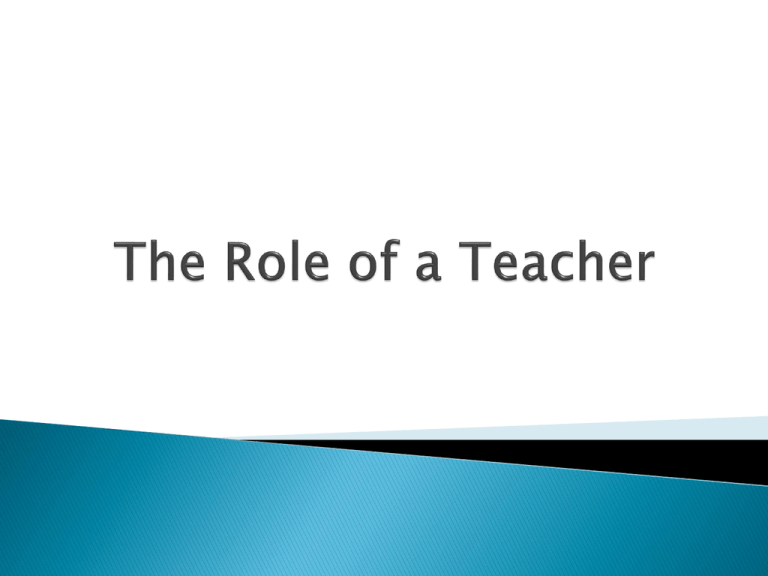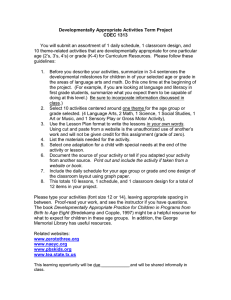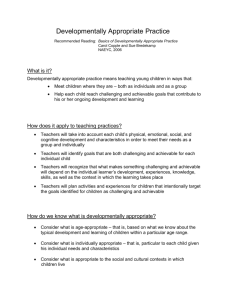The Role of a Teacher
advertisement

“… is grounded in the research on child development and learning and in the knowledge base regarding educational effectiveness” (Copple & Bredekamp, 2009, p.33) Our knowledge base consist of how children learn at different ages and what strategies work best for each age Teachers exhibit this knowledge in every day decisions like… ◦ Environment ◦ Plan curriculum to reach goals ◦ Teaching strategies for a group or individual children Question “is this decision developmentally appropriate?” ◦ It depends on children, families, context, purpose Creating a learning environment Tailoring curriculum to individual children Plan learning experience Interacting with children Interacting with families Teachable moments Community of Learners Families Assessment Teaching Curriculum To create a classroom community ◦ Get to know children and the family Teacher plans cooperative play among children. ◦ Bringing home culture into the classroom ◦ Inclusion of all children Teacher develops a warm, positive relationship with each child Social and emotional competence are essential curricular goals Guidance is effective when teachers help children learn ◦ Model problem solving ◦ Help children make better decisions next time An effective teacher makes use of the strategy that fits a particular situation She considers what a child already knows Has different strategies and remaining flexible Observes children to see which of these strategies might work Acknowledge what the children do or say Encourage persistence and effort rather than just praising and evaluating Give specific feedback rather than general comments Model attitudes, ways of approaching problems, and behavior towards others Demonstrate the correct way to do something Create or add challenge so that a task goes a bit beyond what the children can already do Give assistance to help children work on the edge of their current competence Provides information directly giving children facts Give directions for children’s action or behavior Ask questions the provoke children’s thinking Teachers engage children in problem solving and to generate ideas As a child begins to acquire new skills the teacher gradually reduces her support (scaffolding) Teacher use a variety of learning formats ◦ ◦ ◦ ◦ Large group Small group Play/learning centers Routine of the day “The curriculum consists of the knowledge and skills to be acquired in the educational program as well as the plans for experiences through which children’s learning will take place” (p.41). Curriculum has clearly defined goals understood by all Curriculum is much more than a collection of activities Activities need to be sequential Young children learn best when the concepts they are learning about are related to something they are already know Each skill should be introduced when prior learning has prepared children for it Teachers adapt curriculum if necessary for children to have sufficient time to learn a topic Assessment is the process of looking at children’s progress toward goals intended in the curriculum Assessment is essential to developmentally appropriate practices in order to: ◦ ◦ ◦ ◦ Monitor children’s development Guide planning and decision making Identify children who need special services Report and communicate with family How do you assess a child? ◦ Observation Appropriate for the child’s age Individually appropriate Culturally appropriate By observing children’s interests, exploration, and how they use the materials in their environment is used to modify the classroom routine Excellent teachers work hard to develop reciprocal relationships with families, communication and respect in both directions (p.45) Families are wealth of information and knowledge regarding their child Children feel more secure when they see the adults who take care of them share trust and respect Intentional steps to build such partnerships ◦ Making families feel welcomed ◦ Open dialogue ◦ Two way communication ◦ Acknowledge parents’ choices Be aware of cultural differences “Practice brings mastery; mastery brings the pleasure and confidence to once again act on curiosity. All learning-emotional, social, motor and cognitive-is accelerated and facilitated by repetition fueled by the pleasure of play.” (Perry, Hogan, & Marlin 2000)

